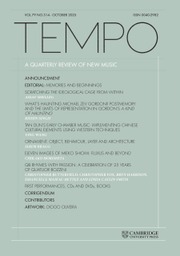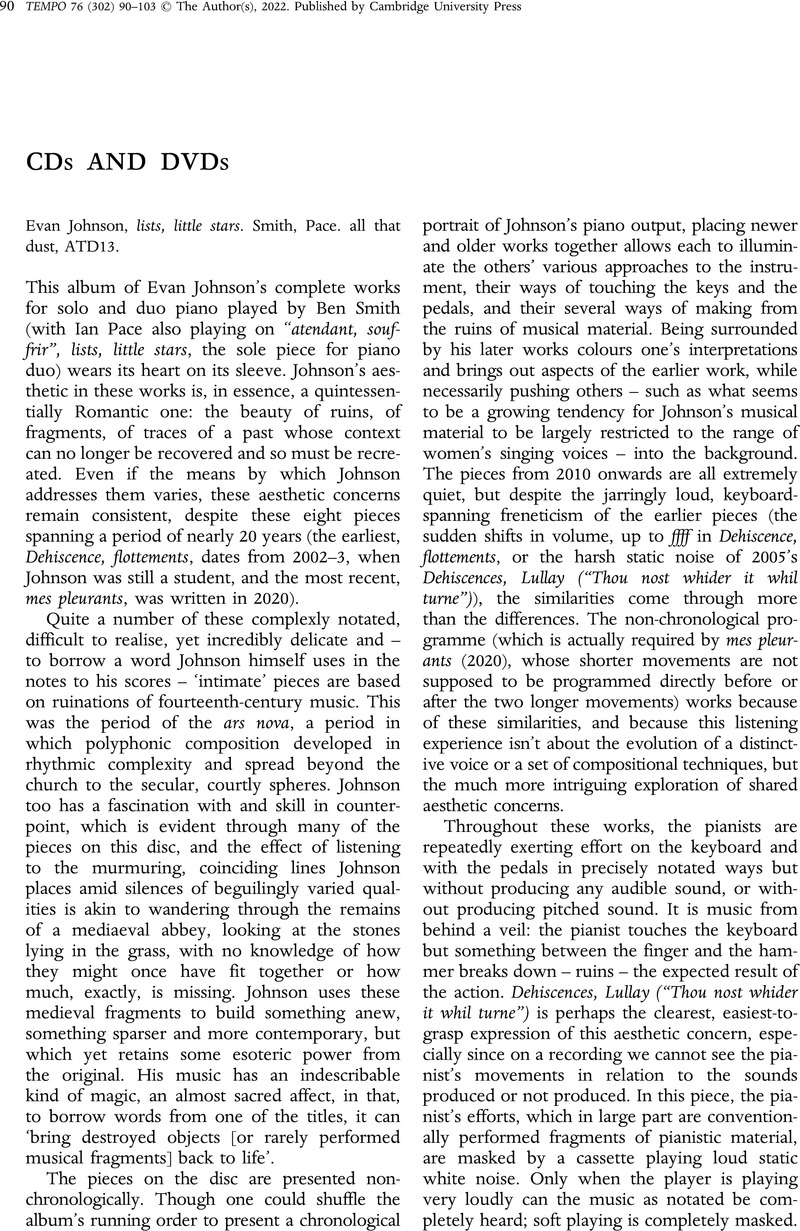This album of Evan Johnson's complete works for solo and duo piano played by Ben Smith (with Ian Pace also playing on “atendant, souffrir”, lists, little stars, the sole piece for piano duo) wears its heart on its sleeve. Johnson's aesthetic in these works is, in essence, a quintessentially Romantic one: the beauty of ruins, of fragments, of traces of a past whose context can no longer be recovered and so must be recreated. Even if the means by which Johnson addresses them varies, these aesthetic concerns remain consistent, despite these eight pieces spanning a period of nearly 20 years (the earliest, Dehiscence, flottements, dates from 2002–3, when Johnson was still a student, and the most recent, mes pleurants, was written in 2020).
Quite a number of these complexly notated, difficult to realise, yet incredibly delicate and – to borrow a word Johnson himself uses in the notes to his scores – ‘intimate’ pieces are based on ruinations of fourteenth-century music. This was the period of the ars nova, a period in which polyphonic composition developed in rhythmic complexity and spread beyond the church to the secular, courtly spheres. Johnson too has a fascination with and skill in counterpoint, which is evident through many of the pieces on this disc, and the effect of listening to the murmuring, coinciding lines Johnson places amid silences of beguilingly varied qualities is akin to wandering through the remains of a mediaeval abbey, looking at the stones lying in the grass, with no knowledge of how they might once have fit together or how much, exactly, is missing. Johnson uses these medieval fragments to build something anew, something sparser and more contemporary, but which yet retains some esoteric power from the original. His music has an indescribable kind of magic, an almost sacred affect, in that, to borrow words from one of the titles, it can ‘bring destroyed objects [or rarely performed musical fragments] back to life’.
The pieces on the disc are presented non-chronologically. Though one could shuffle the album's running order to present a chronological portrait of Johnson's piano output, placing newer and older works together allows each to illuminate the others’ various approaches to the instrument, their ways of touching the keys and the pedals, and their several ways of making from the ruins of musical material. Being surrounded by his later works colours one's interpretations and brings out aspects of the earlier work, while necessarily pushing others – such as what seems to be a growing tendency for Johnson's musical material to be largely restricted to the range of women's singing voices – into the background. The pieces from 2010 onwards are all extremely quiet, but despite the jarringly loud, keyboard-spanning freneticism of the earlier pieces (the sudden shifts in volume, up to ffff in Dehiscence, flottements, or the harsh static noise of 2005's Dehiscences, Lullay (“Thou nost whider it whil turne”)), the similarities come through more than the differences. The non-chronological programme (which is actually required by mes pleurants (2020), whose shorter movements are not supposed to be programmed directly before or after the two longer movements) works because of these similarities, and because this listening experience isn't about the evolution of a distinctive voice or a set of compositional techniques, but the much more intriguing exploration of shared aesthetic concerns.
Throughout these works, the pianists are repeatedly exerting effort on the keyboard and with the pedals in precisely notated ways but without producing any audible sound, or without producing pitched sound. It is music from behind a veil: the pianist touches the keyboard but something between the finger and the hammer breaks down – ruins – the expected result of the action. Dehiscences, Lullay (“Thou nost whider it whil turne”) is perhaps the clearest, easiest-to-grasp expression of this aesthetic concern, especially since on a recording we cannot see the pianist's movements in relation to the sounds produced or not produced. In this piece, the pianist's efforts, which in large part are conventionally performed fragments of pianistic material, are masked by a cassette playing loud static white noise. Only when the player is playing very loudly can the music as notated be completely heard; soft playing is completely masked. Later pieces vary the technique of masking to produce much more private, claustrophobic soundscapes: three reversed movements, to bring destroyed objects back to life (2014) has the player play a piano with the lid down and the una corda (soft) pedal continuously depressed and muffled by the fabric cover used to protect pianos in storage. In the most recent pieces, Johnson makes use of a playing technique of half-depressing the key before playing, much reducing the kinetic energy of the hammer and bringing into question, at times, whether the half-struck key will in fact produce a pitched sound at all. In all these cases, despite the clear visual element involved in the subversion of audiences’ expectations, Johnson's rigorous ear ensures that the purely aural experience of these pieces remains a compelling rumination on thwarted, stifled and repressed sounds, nonetheless making their way to our ears.
That said, the microphone has an even more private relationship with the pianos’ internal workings and resonances than the performer. Within these pieces there are sounds of such low volume that in a live performance only the performer could hear them but which, in a beautifully close-recorded album such as this, are not only audible but very clearly so. Take, for example, the shortest single work on the album, hwil (2010), a 45-second piece which has more silence than sound, and more internal percussive sounds than pitched ones. The recording brings out every movement of the keys, levels, shanks and even the pianist's inhalations (which are notated in the score). But as gorgeously detailed as these recordings are to listen to on headphones, I ended up choosing to listen on speakers in order to simulate something of the distance of a concert performance. Aside from the white noise of Dehiscences, Lullay, when listened to on headphones the other pieces were too perfect – that is, not ‘ruined’ enough – for my taste. This subjective reaction, though, is not a fault, but speaks to the powerful intimacy of the music, Smith's and Pace's considered interpretations and the all that dust team's production.
The overall impression left by this collection, this documentation of determined innovation over the span of Johnson's career so far via and with ruins from Europe's musical past, is of a profound and enchanting aesthetic experience. It is an expression of the sublimity of rupture and decay, and of making something contemporary out of the ruins of the past.




